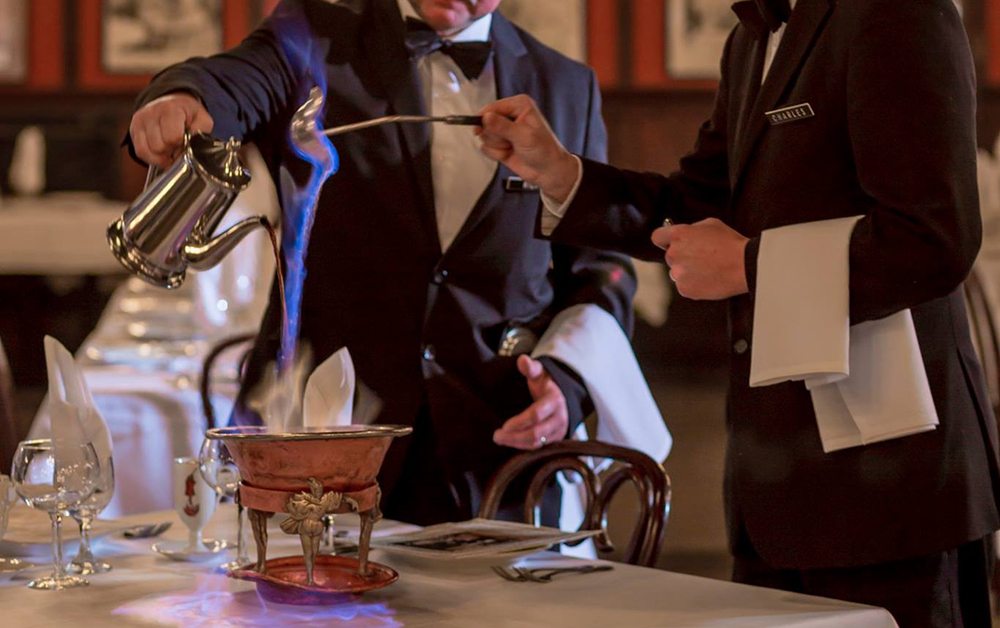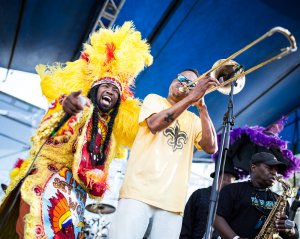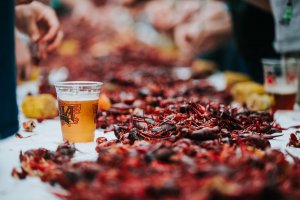Light My Fire: The Spectacle and Tradition of Café Brûlot

Photo courtesy of Antoine’s Restaurant on Facebook
A lot of towns have dinner theater, but in New Orleans dinner is theater. This is especially true in the old-line Creole restaurants where locals and visitors partake in dining experiences as cultural and theatrical as they are culinary. In these terms, the New Orleans postprandial libation known as café brûlot can be considered a special effect, or maybe even pyrotechnics.
What Is Café Brûlot?
This is no ordinary after-dinner drink, nor is it readily available at ordinary restaurants. It’s made with specialized equipment, in portions large enough for at least several servings, and it comes with a choreographed tableside preparation sure to temporarily supersede conversation not only at your table but usually at all those within earshot.
The name, of course, comes from the French: café, or coffee, and brûlot, which can mean either “highly seasoned” or “incendiary,” both of which prove apt for this singular drink. A list of ingredients in the classic café brûlot recipe helps illuminate its elaborate nature. Most preparations call for an orange peel cut precisely as one long, intact spiral; a lemon peel cut into strips; sugar, cloves and cinnamon; cognac or brandy and hot, strong black coffee. Most importantly, the drink requires fire.
The Flaming Finale: How Café Brûlot Is Made
It ends up tasting like very thick, sweet coffee with the deep citrus and clove flavors mellowing the sweetness. Many diners say they prefer the second cup to the first, since the concoction has had time to steep a little more. Though the drink is ordered year-round, café brûlot’s hot temperature and rich, bold flavor make it a particularly enjoyable way to end dinner on a cooler winter night. It is especially popular as a finale to a big holiday meal, such as the New Orleans Reveillon feast.
However delicious and reviving it may be, getting there is more than half the fun when it comes to café brûlot.
The recipe is so special, it requires its own exotic equipment to make. This includes a silver bowl, a circular tray and a long-handled ladle. The brandy mixture is poured into the bowl, which is surrounded by a small amount of alcohol in the circular tray. The coffee is brought to the table steaming hot and added to the brandy. In many cases, the lights of the dining room will then be dimmed to accentuate the impending dance of flame that accompanies the final steps of this drink’s dramatic preparation.
The waiter ignites the alcohol with a match and allows the fire to heat up the contents of the bowl, which grows increasingly aromatic. The waiter then dips the long ladle into the mixture, ignites it from the flame surrounding the bowl, and carries the flame back to set off the brandy.
Quickly, while the mixture is still flaming, the waiter will hold the spiraled orange peel over the bowl with a fork and proceed to ladle the flaming coffee mixture down the peel repeatedly. The technique creates a mesmerizing ribbon of blue-gold flame that inspires choruses of oohs and ahhs around the dining room whenever it is done right.
Where to Try Café Brûlot in the French Quarter
The spectacular preparation gives the term mixed drink a whole new meaning, and it is certainly a job best left to experienced professionals. Want to try café brûlot? Here are our top recommendations for the French Quarter.
Antoine’s Restaurant (713 St. Louis St.) lays claim to the invention of café brûlot, and gives the credit to Jules Alciatore, son of founder and namesake Antoine Alciatore, sometime in the 1890s. The drink enjoyed special popularity during Prohibition, when coffee provided cover for the then-contraband alcohol.
Café brûlot also became a house specialty of other old-line Creole restaurants, as it remains today, including Galatoire’s Restaurant (209 Bourbon St.), Broussard’s (819 Conti St.), and Arnaud’s Restaurant (813 Bienville St.), which happened to open for business the same year the federally-mandated deprivations of Prohibition began.
Restaurant lore at Arnaud’s holds that special coffee drinks were also used there to disguise liquor libations. Today, however, ordering a café brûlot with all its attendant ceremony and ritual is one of the worst ways to be inconspicuous in a formal New Orleans dining room. It is also one of the most memorable ways to cap off a glorious New Orleans meal.
Don’t miss out on all the excitement the French Quarter has to offer all year round, round the clock! Book your room at any of these historic hotels today.





